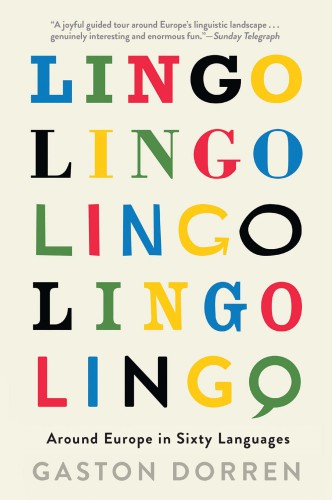
Lingo
Around Europe in Sixty Languages
کتاب های مرتبط
- اطلاعات
- نقد و بررسی
- دیدگاه کاربران
نقد و بررسی

October 12, 2015
In this bubbly linguistic endeavor, journalist and polyglot Dorren covers the evolution and peccadillos of 60 European languages starting with Proto-Indo European, which, while not the first language, is the mother tongue of Europe. Dorren thoughtfully walks readers through the weird evolution of languages (including sign language and its variants), addressing language familial relations and specific dialects (e.g., the “half-language” of Scots) with quirky tidbits aplenty, such as the story of Tuone Udaina, the last living speaker of Dalmatian, who died in 1898 before the language could be recorded. Dorren dedicates a chapter to each language and closes with a handful of the most popular “loanwords” words from it—ones that have made their way into the common vernacular (English speakers can thank the Czechs for robot) as well as ones that should, such as beloruchka, a Russian term for someone who avoids work. Rounded out with helpful insights, such as the impact of Martin Luther, the author (and Reformation leader) who inadvertently unified the German language, and the refutation of the notion that Eskimos have 100 words for snow (it’s actually the Inari-Sami language of Finland, and there are really only 20 words), Dorren has crafted an immersive and illuminating study of something many of us take for granted. Agent: Caroline Dawnay, United Agents.

September 1, 2015
Quirky facts about 60 European languages. In his debut book in English, Dutch linguist and journalist Dorren, who speaks six languages and reads nine more, explores the origins, families, vocabularies, and grammars of 60 languages, dead (Dalmation), dying (Gaeltacht Irish), and alive. The political map of the continent appears as "a mass of solid monochromatic blocks," the author writes, but a map of languages looks "more like a multi-colored mosaic in many places, while in other regions it resembles a floor that's been sprinkled with confetti." While he reveals many intriguing nuggets of information about languages from the familiar (French, German, Spanish) to the arcane (Manx, Ossetian, Sorbian), he assumes that readers have a fairly sophisticated knowledge of grammatical terms: absolutives, augmentatives, demonstratives, case, reflexive possessive pronouns, and ergative verbs may not be in every reader's vocabulary. It helps to know the difference between subject and object, too, in order to grasp why the terms "agent" and "patient" are more appropriate to understanding Basque grammar. At the end of each chapter, Dorren cites a few words imported from that language into English: "anchovy," from Portuguese; "avalanche" from Romansh (through French); "get" and "egg" from Early Norwegian. But nothing, sadly, from Latvian, or from Monegasque, a subdialect of Ligurian, spoken by about 100 people in Monaco. Besides borrowed words, Dorren suggests idiosyncratic terms that might well be taken up by English speakers: "Beloruchka," Russian for a " 'white-hand person'; somebody who shirks dirty work"; or, from Slovak, "Proznovit," "to make someone's phone ring just once in the hope that they will call back." The author describes his book as an "amuse-bouche," a tasty morsel that gives diners a hint of a chef's talent, and he certainly displays his own linguistic talents and enthusiasm for languages. Too often, however, he tells what people speak and where rather than how a language transformed and why. For linguists and readers truly thrilled by the meticulous study of languages.
COPYRIGHT(2015) Kirkus Reviews, ALL RIGHTS RESERVED.

November 1, 2015
As author Dorren astutely notes in his introduction, the attitude of English speakers to foreign languages is generally simple: Let's plunder, not learn them. Yet here's a book, filled with photos, charts, and more, delineating both what English speakers have missed stealing and from where they stole, and it's wonderfulfrom a list of the Inari-Sami's 20 words for snow to Charlie Chaplin's Esperanto (well, Esperanto-like) signs in The Great Dictator. And Dorren doesn't just focus on Europe's languages and their families, histories, politics, vocabularies, and grammar but also on, for example, Movers and Shakers, whom he calls linguists who left their mark. Many of the often short, always interesting chapters end with a word already in use from a particular language and another that could be functional in English (e.g., the modern Norwegian word utepils, a lager drunk in the open air ). This intriguing, thoughtful book will delight those who love words; it is also a round, solid education in the vastness of the world's citizens' ability and desire to express themselves, intended, Dorren states, as an amuse-bouche. Amusing, too!(Reprinted with permission of Booklist, copyright 2015, American Library Association.)

July 1, 2015
Dutch linguist Dorren speaks Dutch, Limburgish, English, German, French, and Spanish and reads nine more languages, so he's the man to write this guide to 60 European languages and dialects, clarifying their similarities (most European languages are descended from a single ancestor, known as Proto-Indo-European, or PIE), differences, and charming quirks. Along the way, readers visit remote mountain villages of Switzerland where Romansh is still spoken and learn that until the 1960s in Sweden polite speaking conventions required that one never use the word you in conversation. Already a big hit in the UK.
Copyright 2015 Library Journal, LLC Used with permission.

























دیدگاه کاربران